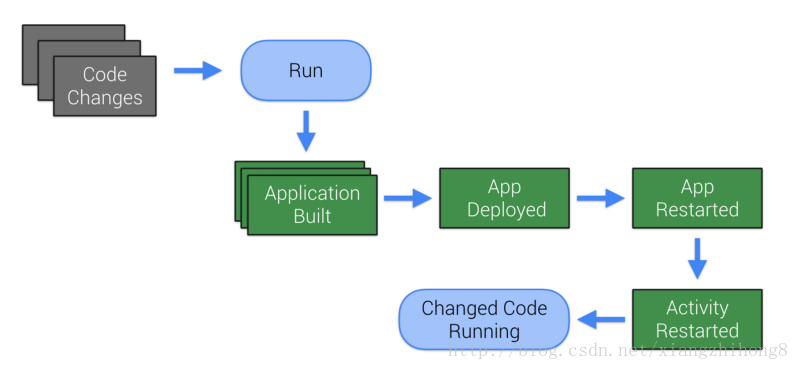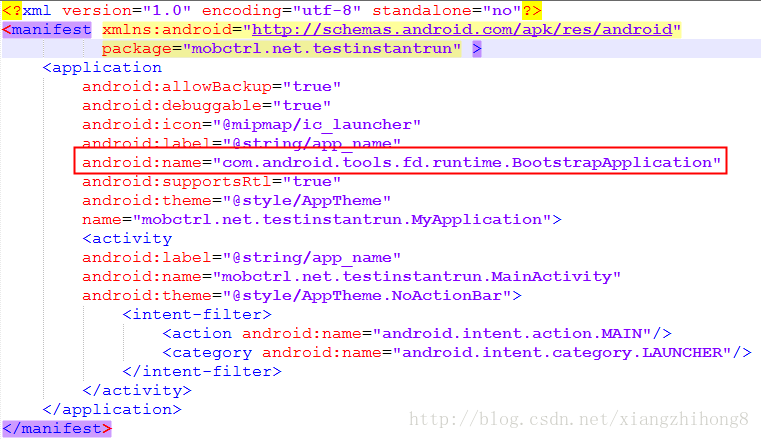Instant Run
Instant Run,是Android studio2.0新增的一个运行机制,在你编码开发、测试或debug的时候,它都能显著减少你对当前应用的构建和部署的时间。通俗的解释就是,当你在Android Studio中改了你的代码,Instant Run可以很快的让你看到你修改的效果。而在没有Instant Run之前,你的一个小小的修改,都肯能需要几十秒甚至更长的等待才能看到修改后的效果。
传统的代码修改及编译部署流程
传统的代码修改及编译流程如下:构建整个apk 部署app app重启 重启Activity

Instant Run编译和部署流程
Instant Run构建项目的流程:构建修改的部分 部署修改的dex或资源 热部署,温部署,冷部署
热拔插,温拔插,冷拔插
热拔插:代码改变被应用、投射到APP上,不需要重启应用,不需要重建当前activity。
场景:适用于多数的简单改变(包括一些方法实现的修改,或者变量值修改)
**温拔插:**activity需要被重启才能看到所需更改。
场景:典型的情况是代码修改涉及到了资源文件,即resources。
**冷拔插:**app需要被重启(但是仍然不需要重新安装)
场景:任何涉及结构性变化的,比如:修改了继承规则、修改了方法签名等。
首次运行Instant Run,Gradle执行过程
一个新的App Server类会被注入到App中,与Bytecode instrumentation协同监控代码的变化。
同时会有一个新的Application类,它注入了一个自定义类加载器(Class Loader),同时该Application类会启动我们所需的新注入的App Server。于是,Manifest会被修改来确保我们的应用能使用这个新的Application类。(这里不必担心自己继承定义了Application类,Instant Run添加的这个新Application类会代理我们自定义的Application类)
至此,Instant Run已经可以跑起来了,在我们使用的时候,它会通过决策,合理运用冷温热拔插来协助我们大量地缩短构建程序的时间。
在Instant Run运行之前,Android Studio会检查是否能连接到App Server中。并且确保这个App Server是Android Studio所需要的。这同样能确保该应用正处在前台。
热拔插

Android Studio monitors: 运行着Gradle任务来生成增量.dex文件(这个dex文件是对应着开发中的修改类) Android Studio会提取这些.dex文件发送到App Server,然后部署到App(Gradle修改class的原理,请戳链接)。
App Server会不断监听是否需要重写类文件,如果需要,任务会被立马执行。新的更改便能立即被响应。我们可以通过打断点的方式来查看。
温拔插
温拔插需要重启Activity,因为资源文件是在Activity创建时加载,所以必须重启Activity来重载资源文件。
目前来说,任何资源文件的修改都会导致重新打包再发送到APP。但是,google的开发团队正在致力于开发一个增量包,这个增量包只会包装修改过的资源文件并能部署到当前APP上。
所以温拔插实际上只能应对少数的情况,它并不能应付应用在架构、结构上的变化。
注:温拔插涉及到的资源文件修改,在manifest上是无效的(这里的无效是指不会启动Instant Run),因为,manifest的值是在APK安装的时候被读取,所以想要manifest下资源的修改生效,还需要触发一个完整的应用构建和部署。
冷拔插
应用部署的时候,会把工程拆分成十个部分,每部分都拥有自己的.dex文件,然后所有的类会根据包名被分配给相应的.dex文件。当冷拔插开启时,修改过的类所对应的.dex文件,会重组生成新的.dex文件,然后再部署到设备上。
之所以能这么做,是依赖于Android的ART模式,它能允许加载多个.dex文件。ART模式在android4.4(API-19)中加入,但是Dalvik依然是首选,到了android5.0(API-21),ART模式才成为系统默认首选,所以Instant Run只能运行在API-21及其以上版本。
使用Instant Run一些注意点
Instant Run是被Android Studio控制的。所以我们只能通过IDE来启动它,如果通过设备来启动应用,Instant Run会出现异常情况。在使用Instant Run来启动Android app的时候,应注意以下几点:
如果应用的minSdkVersion小于21,可能多数的Instant Run功能会挂掉,这里提供一个解决方法,通过product flavor建立一个minSdkVersion大于21的新分支,用来debug。
Instant Run目前只能在主进程里运行,如果应用是多进程的,类似微信,把webView抽出来单独一个进程,那热、温拔插会被降级为冷拔插。
在Windows下,Windows Defender Real-Time Protection可能会导致Instant Run挂掉,可用通过添加白名单列表解决。
暂时不支持Jack compiler,Instrumentation Tests,或者同时部署到多台设备。
结合Demo深度理解
为了方便大家的理解,我们新建一个项目,里面不写任何的逻辑功能,只对application做一个修改:

首先,我们先反编译一下APK的构成,使用的工具:d2j-dex2jar 和jd-gui。

我们要看的启动的信息就在这个instant-run.zip文件里面,解压instant-run.zip,我们会发现,我们真正的业务代码都在这里。

从instant-run文件中我们猜想是BootstrapApplication替换了我们的application,Instant-Run代码作为一个宿主程序,将app作为资源dex加载起来。
那么InstantRun是怎么把业务代码运行起来的呢?
Instant Run如何启动app
按照我们上面对instant-run运行机制的猜想,我们首先看一下appliaction的分析attachBaseContext和onCreate方法。
attachBaseContext()
protected void attachBaseContext(Context context) {if (!AppInfo.usingApkSplits) {
String apkFile = context.getApplicationInfo().sourceDir;long apkModified = apkFile != null ? new File(apkFile)
.lastModified() : 0L;
createResources(apkModified);
setupClassLoaders(context, context.getCacheDir().getPath(),
apkModified);
}
createRealApplication();super.attachBaseContext(context);if (this.realApplication != null) {try {
Method attachBaseContext = ContextWrapper.class
.getDeclaredMethod("attachBaseContext",new Class[] { Context.class });
attachBaseContext.setAccessible(true);
attachBaseContext.invoke(this.realApplication,new Object[] { context });
} catch (Exception e) {throw new IllegalStateException(e);
}
}
}我们依次需要关注的方法有:
createResources setupClassLoaders createRealApplication 调用realApplication的attachBaseContext方法
createResources()
private void createResources(long apkModified) {
FileManager.checkInbox();
File file = FileManager.getExternalResourceFile();this.externalResourcePath = (file != null ? file.getPath() : null);if (Log.isLoggable("InstantRun", 2)) {
Log.v("InstantRun", "Resource override is "+ this.externalResourcePath);
}if (file != null) {try {long resourceModified = file.lastModified();if (Log.isLoggable("InstantRun", 2)) {
Log.v("InstantRun", "Resource patch last modified: "+ resourceModified);
Log.v("InstantRun", "APK last modified: " + apkModified
+ " "+ (apkModified > resourceModified ? ">" : "<")
+ " resource patch");
}if ((apkModified == 0L) || (resourceModified <= apkModified)) {if (Log.isLoggable("InstantRun", 2)) {
Log.v("InstantRun","Ignoring resource file, older than APK");
}this.externalResourcePath = null;
}
} catch (Throwable t) {
Log.e("InstantRun", "Failed to check patch timestamps", t);
}
}
}说明:该方法主要是判断资源resource.ap_是否改变,然后保存resource.ap_的路径到externalResourcePath中。
setupClassLoaders()
private static void setupClassLoaders(Context context, String codeCacheDir,long apkModified) {
List dexList = FileManager.getDexList(context, apkModified);
Class server = Server.class;
Class patcher = MonkeyPatcher.class;if (!dexList.isEmpty()) {if (Log.isLoggable("InstantRun", 2)) {
Log.v("InstantRun", "Bootstrapping class loader with dex list "+ join('\n', dexList));
}
ClassLoader classLoader = BootstrapApplication.class.getClassLoader();
String nativeLibraryPath;try {
nativeLibraryPath = (String) classLoader.getClass()
.getMethod("getLdLibraryPath", new Class[0])
.invoke(classLoader, new Object[0]);if (Log.isLoggable("InstantRun", 2)) {
Log.v("InstantRun", "Native library path: "+ nativeLibraryPath);
}
} catch (Throwable t) {
Log.e("InstantRun", "Failed to determine native library path "+ t.getMessage());
nativeLibraryPath = FileManager.getNativeLibraryFolder()
.getPath();
}
IncrementalClassLoader.inject(classLoader, nativeLibraryPath,
codeCacheDir, dexList);
}
}说明,该方法是初始化一个ClassLoaders并调用IncrementalClassLoader。
IncrementalClassLoader的源码如下:
public class IncrementalClassLoader extends ClassLoader {public static final boolean DEBUG_CLASS_LOADING = false;private final DelegateClassLoader delegateClassLoader;public IncrementalClassLoader(ClassLoader original,
String nativeLibraryPath, String codeCacheDir, List dexes) {super(original.getParent());this.delegateClassLoader = createDelegateClassLoader(nativeLibraryPath,
codeCacheDir, dexes, original);
}public Class findClass(String className) throws ClassNotFoundException {try {return this.delegateClassLoader.findClass(className);
} catch (ClassNotFoundException e) {throw e;
}
}private static class DelegateClassLoader extends BaseDexClassLoader {private DelegateClassLoader(String dexPath, File optimizedDirectory,
String libraryPath, ClassLoader parent) {super(dexPath, optimizedDirectory, libraryPath, parent);
}public Class findClass(String name) throws ClassNotFoundException {try {return super.findClass(name);
} catch (ClassNotFoundException e) {throw e;
}
}
}private static DelegateClassLoader createDelegateClassLoader(
String nativeLibraryPath, String codeCacheDir, List dexes,
ClassLoader original) {
String pathBuilder = createDexPath(dexes);return new DelegateClassLoader(pathBuilder, new File(codeCacheDir),
nativeLibraryPath, original);
}private static String createDexPath(List dexes) {
StringBuilder pathBuilder = new StringBuilder();boolean first = true;for (String dex : dexes) {if (first) {
first = false;
} else {
pathBuilder.append(File.pathSeparator);
}
pathBuilder.append(dex);
}if (Log.isLoggable("InstantRun", 2)) {
Log.v("InstantRun", "Incremental dex path is "+ BootstrapApplication.join('\n', dexes));
}return pathBuilder.toString();
}private static void setParent(ClassLoader classLoader, ClassLoader newParent) {try {
Field parent = ClassLoader.class.getDeclaredField("parent");
parent.setAccessible(true);
parent.set(classLoader, newParent);
} catch (IllegalArgumentException e) {throw new RuntimeException(e);
} catch (IllegalAccessException e) {throw new RuntimeException(e);
} catch (NoSuchFieldException e) {throw new RuntimeException(e);
}
}public static ClassLoader inject(ClassLoader classLoader,
String nativeLibraryPath, String codeCacheDir, List dexes) {
IncrementalClassLoader incrementalClassLoader = new IncrementalClassLoader(
classLoader, nativeLibraryPath, codeCacheDir, dexes);
setParent(classLoader, incrementalClassLoader);return incrementalClassLoader;
}
}inject方法是用来设置classloader的父子顺序的,使用IncrementalClassLoader来加载dex。由于ClassLoader的双亲委托模式,也就是委托父类加载类,父类中找不到再在本ClassLoader中查找。
调用的效果图如下:

为了方便我们对委托父类加载机制的理解,我们可以做一个实验,在我们的application做一些Log。
@Overridepublic void onCreate() {super.onCreate();try{
Log.d(TAG,"###onCreate in myApplication");
String classLoaderName = getClassLoader().getClass().getName();
Log.d(TAG,"###onCreate in myApplication classLoaderName = "+classLoaderName);
String parentClassLoaderName = getClassLoader().getParent().getClass().getName();
Log.d(TAG,"###onCreate in myApplication parentClassLoaderName = "+parentClassLoaderName);
String pParentClassLoaderName = getClassLoader().getParent().getParent().getClass().getName();
Log.d(TAG,"###onCreate in myApplication pParentClassLoaderName = "+pParentClassLoaderName);
}catch (Exception e){
e.printStackTrace();
}
}输出结果:
03-20 10:43:42.475 27307-27307/mobctrl.net.testinstantrun D/MyApplication: ###onCreate in myApplication classLoaderName = dalvik.system.PathClassLoader03-20 10:43:42.475 27307-27307/mobctrl.net.testinstantrun D/MyApplication: ###onCreate in myApplication parentClassLoaderName = com.android.tools.fd.runtime.IncrementalClassLoader03-20 10:43:42.475 27307-27307/mobctrl.net.testinstantrun D/MyApplication: ###onCreate in myApplication pParentClassLoaderName = java.lang.BootClassLoader
由此,我们知道,当前PathClassLoader委托IncrementalClassLoader加载dex。
我们继续对attachBaseContext()继续分析:
attachBaseContext.invoke(this.realApplication,new Object[] { context });createRealApplication
private void createRealApplication() {if (AppInfo.applicationClass != null) {if (Log.isLoggable("InstantRun", 2)) {
Log.v("InstantRun","About to create real application of class name = "+ AppInfo.applicationClass);
}try {
Class realClass = (Class) Class
.forName(AppInfo.applicationClass);if (Log.isLoggable("InstantRun", 2)) {
Log.v("InstantRun","Created delegate app class successfully : "+ realClass + " with class loader "+ realClass.getClassLoader());
}
Constructor constructor = realClass
.getConstructor(new Class[0]);this.realApplication = ((Application) constructor
.newInstance(new Object[0]));if (Log.isLoggable("InstantRun", 2)) {
Log.v("InstantRun","Created real app instance successfully :"+ this.realApplication);
}
} catch (Exception e) {throw new IllegalStateException(e);
}
} else {this.realApplication = new Application();
}
}该方法就是用classes.dex中的AppInfo类的applicationClass常量中保存的app真实的application。由例子的分析我们可以知道applicationClass就是com.xzh.demo.MyApplication。通过反射的方式,创建真是的realApplication。
看完attachBaseContext我们继续看BootstrapApplication();
BootstrapApplication()
我们首先看一下onCreate方法:
onCreate()
public void onCreate() {if (!AppInfo.usingApkSplits) {
MonkeyPatcher.monkeyPatchApplication(this, this,this.realApplication, this.externalResourcePath);
MonkeyPatcher.monkeyPatchExistingResources(this,this.externalResourcePath, null);
} else {
MonkeyPatcher.monkeyPatchApplication(this, this,this.realApplication, null);
}super.onCreate();if (AppInfo.applicationId != null) {try {boolean foundPackage = false;int pid = Process.myPid();
ActivityManager manager = (ActivityManager) getSystemService("activity");
List processes = manager
.getRunningAppProcesses();boolean startServer = false;if ((processes != null) && (processes.size() > 1)) {for (ActivityManager.RunningAppProcessInfo processInfo : processes) {if (AppInfo.applicationId
.equals(processInfo.processName)) {
foundPackage = true;if (processInfo.pid == pid) {
startServer = true;break;
}
}
}if ((!startServer) && (!foundPackage)) {
startServer = true;if (Log.isLoggable("InstantRun", 2)) {
Log.v("InstantRun","Multiprocess but didn't find process with package: starting server anyway");
}
}
} else {
startServer = true;
}if (startServer) {
Server.create(AppInfo.applicationId, this);
}
} catch (Throwable t) {if (Log.isLoggable("InstantRun", 2)) {
Log.v("InstantRun", "Failed during multi process check", t);
}
Server.create(AppInfo.applicationId, this);
}
}if (this.realApplication != null) {this.realApplication.onCreate();
}
}在onCreate()中我们需要注意以下方法:
monkeyPatchApplication monkeyPatchExistingResources Server启动 调用realApplication的onCreate方法
monkeyPatchApplication
public static void monkeyPatchApplication(Context context,
Application bootstrap, Application realApplication,
String externalResourceFile) {try {
Class activityThread = Class
.forName("android.app.ActivityThread");
Object currentActivityThread = getActivityThread(context,
activityThread);
Field mInitialApplication = activityThread
.getDeclaredField("mInitialApplication");
mInitialApplication.setAccessible(true);
Application initialApplication = (Application) mInitialApplication
.get(currentActivityThread);if ((realApplication != null) && (initialApplication == bootstrap)) {
mInitialApplication.set(currentActivityThread, realApplication);
}if (realApplication != null) {
Field mAllApplications = activityThread
.getDeclaredField("mAllApplications");
mAllApplications.setAccessible(true);
List allApplications = (List) mAllApplications
.get(currentActivityThread);for (int i = 0; i < allApplications.size(); i++) {if (allApplications.get(i) == bootstrap) {
allApplications.set(i, realApplication);
}
}
}
Class loadedApkClass;try {
loadedApkClass = Class.forName("android.app.LoadedApk");
} catch (ClassNotFoundException e) {
loadedApkClass = Class
.forName("android.app.ActivityThread$PackageInfo");
}
Field mApplication = loadedApkClass
.getDeclaredField("mApplication");
mApplication.setAccessible(true);
Field mResDir = loadedApkClass.getDeclaredField("mResDir");
mResDir.setAccessible(true);
Field mLoadedApk = null;try {
mLoadedApk = Application.class.getDeclaredField("mLoadedApk");
} catch (NoSuchFieldException e) {
}for (String fieldName : new String[] { "mPackages","mResourcePackages" }) {
Field field = activityThread.getDeclaredField(fieldName);
field.setAccessible(true);
Object value = field.get(currentActivityThread);for (Map.Entry> entry : ((Map>) value)
.entrySet()) {
Object loadedApk = ((WeakReference) entry.getValue()).get();if (loadedApk != null) {if (mApplication.get(loadedApk) == bootstrap) {if (realApplication != null) {
mApplication.set(loadedApk, realApplication);
}if (externalResourceFile != null) {
mResDir.set(loadedApk, externalResourceFile);
}if ((realApplication != null)
&& (mLoadedApk != null)) {
mLoadedApk.set(realApplication, loadedApk);
}
}
}
}
}
} catch (Throwable e) {throw new IllegalStateException(e);
}
}说明:该方法的作用是替换所有当前app的application为realApplication。
替换的过程如下:
1.替换ActivityThread的mInitialApplication为realApplication
2.替换mAllApplications 中所有的Application为realApplication
3.替换ActivityThread的mPackages,mResourcePackages中的mLoaderApk中的application为realApplication。
monkeyPatchExistingResources
public static void monkeyPatchExistingResources(Context context,
String externalResourceFile, Collection activities) {if (externalResourceFile == null) {return;
}try {
AssetManager newAssetManager = (AssetManager) AssetManager.class.getConstructor(new Class[0]).newInstance(new Object[0]);
Method mAddAssetPath = AssetManager.class.getDeclaredMethod("addAssetPath", new Class[] { String.class });
mAddAssetPath.setAccessible(true);if (((Integer) mAddAssetPath.invoke(newAssetManager,new Object[] { externalResourceFile })).intValue() == 0) {throw new IllegalStateException("Could not create new AssetManager");
}
Method mEnsureStringBlocks = AssetManager.class.getDeclaredMethod("ensureStringBlocks", new Class[0]);
mEnsureStringBlocks.setAccessible(true);
mEnsureStringBlocks.invoke(newAssetManager, new Object[0]);if (activities != null) {for (Activity activity : activities) {
Resources resources = activity.getResources();try {
Field mAssets = Resources.class.getDeclaredField("mAssets");
mAssets.setAccessible(true);
mAssets.set(resources, newAssetManager);
} catch (Throwable ignore) {
Field mResourcesImpl = Resources.class.getDeclaredField("mResourcesImpl");
mResourcesImpl.setAccessible(true);
Object resourceImpl = mResourcesImpl.get(resources);
Field implAssets = resourceImpl.getClass()
.getDeclaredField("mAssets");
implAssets.setAccessible(true);
implAssets.set(resourceImpl, newAssetManager);
}
Resources.Theme theme = activity.getTheme();try {try {
Field ma = Resources.Theme.class.getDeclaredField("mAssets");
ma.setAccessible(true);
ma.set(theme, newAssetManager);
} catch (NoSuchFieldException ignore) {
Field themeField = Resources.Theme.class.getDeclaredField("mThemeImpl");
themeField.setAccessible(true);
Object impl = themeField.get(theme);
Field ma = impl.getClass().getDeclaredField("mAssets");
ma.setAccessible(true);
ma.set(impl, newAssetManager);
}
Field mt = ContextThemeWrapper.class.getDeclaredField("mTheme");
mt.setAccessible(true);
mt.set(activity, null);
Method mtm = ContextThemeWrapper.class.getDeclaredMethod("initializeTheme",new Class[0]);
mtm.setAccessible(true);
mtm.invoke(activity, new Object[0]);
Method mCreateTheme = AssetManager.class.getDeclaredMethod("createTheme", new Class[0]);
mCreateTheme.setAccessible(true);
Object internalTheme = mCreateTheme.invoke(
newAssetManager, new Object[0]);
Field mTheme = Resources.Theme.class.getDeclaredField("mTheme");
mTheme.setAccessible(true);
mTheme.set(theme, internalTheme);
} catch (Throwable e) {
Log.e("InstantRun","Failed to update existing theme for activity "+ activity, e);
}
pruneResourceCaches(resources);
}
}
Collection> references;if (Build.VERSION.SDK_INT >= 19) {
Class resourcesManagerClass = Class
.forName("android.app.ResourcesManager");
Method mGetInstance = resourcesManagerClass.getDeclaredMethod("getInstance", new Class[0]);
mGetInstance.setAccessible(true);
Object resourcesManager = mGetInstance.invoke(null,new Object[0]);try {
Field fMActiveResources = resourcesManagerClass
.getDeclaredField("mActiveResources");
fMActiveResources.setAccessible(true);
ArrayMap> arrayMap = (ArrayMap) fMActiveResources
.get(resourcesManager);
references = arrayMap.values();
} catch (NoSuchFieldException ignore) {
Field mResourceReferences = resourcesManagerClass
.getDeclaredField("mResourceReferences");
mResourceReferences.setAccessible(true);
references = (Collection) mResourceReferences
.get(resourcesManager);
}
} else {
Class activityThread = Class
.forName("android.app.ActivityThread");
Field fMActiveResources = activityThread
.getDeclaredField("mActiveResources");
fMActiveResources.setAccessible(true);
Object thread = getActivityThread(context, activityThread);
HashMap> map = (HashMap) fMActiveResources
.get(thread);
references = map.values();
}for (WeakReference wr : references) {
Resources resources = (Resources) wr.get();if (resources != null) {try {
Field mAssets = Resources.class.getDeclaredField("mAssets");
mAssets.setAccessible(true);
mAssets.set(resources, newAssetManager);
} catch (Throwable ignore) {
Field mResourcesImpl = Resources.class.getDeclaredField("mResourcesImpl");
mResourcesImpl.setAccessible(true);
Object resourceImpl = mResourcesImpl.get(resources);
Field implAssets = resourceImpl.getClass()
.getDeclaredField("mAssets");
implAssets.setAccessible(true);
implAssets.set(resourceImpl, newAssetManager);
}
resources.updateConfiguration(resources.getConfiguration(),
resources.getDisplayMetrics());
}
}
} catch (Throwable e) {throw new IllegalStateException(e);
}
}说明:该方法的作用是替换所有当前app的mAssets为newAssetManager。
monkeyPatchExistingResources的流程如下:
1.如果resource.ap_文件有改变,那么新建一个AssetManager对象newAssetManager,然后用newAssetManager对象替换所有当前Resource、Resource.Theme的mAssets成员变量。
2.如果当前的已经有Activity启动了,还需要替换所有Activity中mAssets成员变量
判断Server是否已经启动,如果没有启动,则启动Server。然后调用realApplication的onCreate方法代理realApplication的生命周期。
接下来我们分析下Server负责的热部署、温部署和冷部署等问题。
Server热部署、温部署和冷部署
首先重点关注一下Server的内部类SocketServerReplyThread。
SocketServerReplyThread
private class SocketServerReplyThread extends Thread {private final LocalSocket mSocket;
SocketServerReplyThread(LocalSocket socket) {this.mSocket = socket;
}public void run() {try {
DataInputStream input = new DataInputStream(this.mSocket.getInputStream());
DataOutputStream output = new DataOutputStream(this.mSocket.getOutputStream());try {
handle(input, output);
} finally {try {
input.close();
} catch (IOException ignore) {
}try {
output.close();
} catch (IOException ignore) {
}
}return;
} catch (IOException e) {if (Log.isLoggable("InstantRun", 2)) {
Log.v("InstantRun", "Fatal error receiving messages", e);
}
}
}private void handle(DataInputStream input, DataOutputStream output)throws IOException {long magic = input.readLong();if (magic != 890269988L) {
Log.w("InstantRun","Unrecognized header format " + Long.toHexString(magic));return;
}int version = input.readInt();
output.writeInt(4);if (version != 4) {
Log.w("InstantRun","Mismatched protocol versions; app is using version 4 and tool is using version "+ version);
} else {int message;for (;;) {
message = input.readInt();switch (message) {case 7:if (Log.isLoggable("InstantRun", 2)) {
Log.v("InstantRun", "Received EOF from the IDE");
}return;case 2:boolean active = Restarter
.getForegroundActivity(Server.this.mApplication) != null;
output.writeBoolean(active);if (Log.isLoggable("InstantRun", 2)) {
Log.v("InstantRun","Received Ping message from the IDE; returned active = "+ active);
}break;case 3:
String path = input.readUTF();long size = FileManager.getFileSize(path);
output.writeLong(size);if (Log.isLoggable("InstantRun", 2)) {
Log.v("InstantRun", "Received path-exists(" + path
+ ") from the " + "IDE; returned size="+ size);
}break;case 4:long begin = System.currentTimeMillis();
path = input.readUTF();byte[] checksum = FileManager.getCheckSum(path);if (checksum != null) {
output.writeInt(checksum.length);
output.write(checksum);if (Log.isLoggable("InstantRun", 2)) {long end = System.currentTimeMillis();
String hash = new BigInteger(1, checksum)
.toString(16);
Log.v("InstantRun", "Received checksum(" + path
+ ") from the " + "IDE: took "+ (end - begin) + "ms to compute "+ hash);
}
} else {
output.writeInt(0);if (Log.isLoggable("InstantRun", 2)) {
Log.v("InstantRun", "Received checksum(" + path
+ ") from the "+ "IDE: returning ");
}
}break;case 5:if (!authenticate(input)) {return;
}
Activity activity = Restarter
.getForegroundActivity(Server.this.mApplication);if (activity != null) {if (Log.isLoggable("InstantRun", 2)) {
Log.v("InstantRun","Restarting activity per user request");
}
Restarter.restartActivityOnUiThread(activity);
}break;case 1:if (!authenticate(input)) {return;
}
List changes = ApplicationPatch
.read(input);if (changes != null) {boolean hasResources = Server.hasResources(changes);int updateMode = input.readInt();
updateMode = Server.this.handlePatches(changes,
hasResources, updateMode);boolean showToast = input.readBoolean();
output.writeBoolean(true);
Server.this.restart(updateMode, hasResources,
showToast);
}break;case 6:
String text = input.readUTF();
Activity foreground = Restarter
.getForegroundActivity(Server.this.mApplication);if (foreground != null) {
Restarter.showToast(foreground, text);
} else if (Log.isLoggable("InstantRun", 2)) {
Log.v("InstantRun","Couldn't show toast (no activity) : "+ text);
}break;
}
}
}
}
}说明:socket开启后,开始读取数据,当读到1时,获取代码变化的ApplicationPatch列表,然后调用handlePatches来处理代码的变化。
handlePatches
private int handlePatches(List changes,boolean hasResources, int updateMode) {if (hasResources) {
FileManager.startUpdate();
}for (ApplicationPatch change : changes) {
String path = change.getPath();if (path.endsWith(".dex")) {
handleColdSwapPatch(change);boolean canHotSwap = false;for (ApplicationPatch c : changes) {if (c.getPath().equals("classes.dex.3")) {
canHotSwap = true;break;
}
}if (!canHotSwap) {
updateMode = 3;
}
} else if (path.equals("classes.dex.3")) {
updateMode = handleHotSwapPatch(updateMode, change);
} else if (isResourcePath(path)) {
updateMode = handleResourcePatch(updateMode, change, path);
}
}if (hasResources) {
FileManager.finishUpdate(true);
}return updateMode;
}说明:本方法主要通过判断Change的内容,来判断采用什么模式(热部署、温部署或冷部署)
如果后缀为“.dex”,冷部署处理handleColdSwapPatch
如果后缀为“classes.dex.3”,热部署处理handleHotSwapPatch
其他情况,温部署,处理资源handleResourcePatch
handleColdSwapPatch冷部署
private static void handleColdSwapPatch(ApplicationPatch patch) {if (patch.path.startsWith("slice-")) {
File file = FileManager.writeDexShard(patch.getBytes(), patch.path);if (Log.isLoggable("InstantRun", 2)) {
Log.v("InstantRun", "Received dex shard " + file);
}
}
}说明:该方法把dex文件写到私有目录,等待整个app重启,重启之后,使用前面提到的IncrementalClassLoader加载dex即可。
handleHotSwapPatch热部署
private int handleHotSwapPatch(int updateMode, ApplicationPatch patch) {if (Log.isLoggable("InstantRun", 2)) {
Log.v("InstantRun", "Received incremental code patch");
}try {String dexFile = FileManager.writeTempDexFile(patch.getBytes());if (dexFile == null) {
Log.e("InstantRun", "No file to write the code to");return updateMode;
}if (Log.isLoggable("InstantRun", 2)) {
Log.v("InstantRun", "Reading live code from " + dexFile);
}String nativeLibraryPath = FileManager.getNativeLibraryFolder()
.getPath();
DexClassLoader dexClassLoader = new DexClassLoader(dexFile,this.mApplication.getCacheDir().getPath(),
nativeLibraryPath, getClass().getClassLoader());
Class aClass = Class.forName("com.android.tools.fd.runtime.AppPatchesLoaderImpl", true,
dexClassLoader);try {if (Log.isLoggable("InstantRun", 2)) {
Log.v("InstantRun", "Got the patcher class " + aClass);
}
PatchesLoader loader = (PatchesLoader) aClass.newInstance();if (Log.isLoggable("InstantRun", 2)) {
Log.v("InstantRun", "Got the patcher instance " + loader);
}String[] getPatchedClasses = (String[]) aClass
.getDeclaredMethod("getPatchedClasses", new Class[0])
.invoke(loader, new Object[0]);if (Log.isLoggable("InstantRun", 2)) {
Log.v("InstantRun", "Got the list of classes ");for (String getPatchedClass : getPatchedClasses) {
Log.v("InstantRun", "class " + getPatchedClass);
}
}if (!loader.load()) {
updateMode = 3;
}
} catch (Exception e) {
Log.e("InstantRun", "Couldn't apply code changes", e);
e.printStackTrace();
updateMode = 3;
}
} catch (Throwable e) {
Log.e("InstantRun", "Couldn't apply code changes", e);
updateMode = 3;
}return updateMode;
}说明:该方法将patch的dex文件写入到临时目录,然后使用DexClassLoader去加载dex。然后反射调用AppPatchesLoaderImpl类的load方法。
需要强调的是:AppPatchesLoaderImpl继承自抽象类AbstractPatchesLoaderImpl,并实现了抽象方法:getPatchedClasses。而AbstractPatchesLoaderImpl抽象类代码如下:
public abstract class AbstractPatchesLoaderImpl implements PatchesLoader {public abstract String[] getPatchedClasses();public boolean load() {try {for (String className : getPatchedClasses()) {
ClassLoader cl = getClass().getClassLoader();
Class aClass = cl.loadClass(className + "$override");
Object o = aClass.newInstance();
Class originalClass = cl.loadClass(className);
Field changeField = originalClass.getDeclaredField("$change");
changeField.setAccessible(true);
Object previous = changeField.get(null);if (previous != null) {
Field isObsolete = previous.getClass().getDeclaredField("$obsolete");if (isObsolete != null) {
isObsolete.set(null, Boolean.valueOf(true));
}
}
changeField.set(null, o);if ((Log.logging != null)
&& (Log.logging.isLoggable(Level.FINE))) {
Log.logging.log(Level.FINE, String.format("patched %s",new Object[] { className }));
}
}
} catch (Exception e) {if (Log.logging != null) {
Log.logging.log(Level.SEVERE, String.format("Exception while patching %s",new Object[] { "foo.bar" }), e);
}return false;
}return true;
}
}Instant Run热部署原理
由上面的代码分析,我们对Instant Run的流程可以分析如下:
1,在第一次构建apk时,在每一个类中注入了一个$change的成员变量,它实现了IncrementalChange接口,并在每一个方法中,插入了一段类似的逻辑。
IncrementalChange localIncrementalChange = $change;if (localIncrementalChange != null) {localIncrementalChange.access$dispatch("onCreate.(Landroid/os/Bundle;)V", new Object[] { this,
... });return;
}当$change不为空的时候,执行IncrementalChange方法。
2,当我们修改代码中方法的实现之后,点击InstantRun,它会生成对应的patch文件来记录你修改的内容。patch文件中的替换类是在所修改类名的后面追加$override,并实现IncrementalChange接口。
3,生成AppPatchesLoaderImpl类,继承自AbstractPatchesLoaderImpl,并实现getPatchedClasses方法,来记录哪些类被修改了。
4,调用load方法之后,根据getPatchedClasses返回的修改过的类的列表,去加载对应的override类,然后把原有类的change设置为对应的实现了IncrementalChange接口的$override类。
Instant Run运行机制总结
Instant Run运行机制主要涉及到热部署、温部署和冷部署,主要是在第一次运行,app运行时期,有代码修改时。
第一次编译
1.把Instant-Run.jar和instant-Run-bootstrap.jar打包到主dex中
2.替换AndroidManifest.xml中的application配置
3.使用asm工具,在每个类中添加$change,在每个方法前加逻辑
4.把源代码编译成dex,然后存放到压缩包instant-run.zip中
app运行时
1.获取更改后资源resource.ap_的路径
2.设置ClassLoader。setupClassLoader:
使用IncrementalClassLoader加载apk的代码,将原有的BootClassLoader PathClassLoader改为BootClassLoader IncrementalClassLoader PathClassLoader继承关系。
3.createRealApplication:
创建apk真实的application
4.monkeyPatchApplication
反射替换ActivityThread中的各种Application成员变量
5.monkeyPatchExistingResource
反射替换所有存在的AssetManager对象
6.调用realApplication的onCreate方法
7.启动Server,Socket接收patch列表
有代码修改时
1.生成对应的$override类
2.生成AppPatchesLoaderImpl类,记录修改的类列表
3.打包成patch,通过socket传递给app
4.app的server接收到patch之后,分别按照handleColdSwapPatch、handleHotSwapPatch、handleResourcePatch等待对patch进行处理
5.restart使patch生效
在Android插件化、Android热修复、apk加壳/脱壳中借鉴了Instant Run运行机制,所以理解Instant Run运行机制对于向更深层次的研究是很有帮助的,对于我们自己书写框架也是有借鉴意义的。

 随时随地看视频
随时随地看视频




